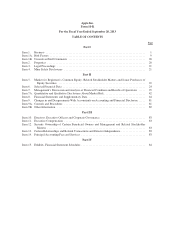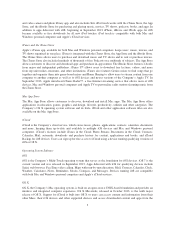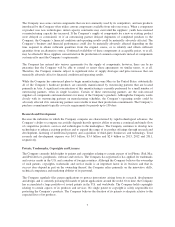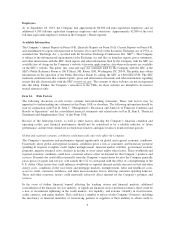Apple 2013 Annual Report Download - page 11
Download and view the complete annual report
Please find page 11 of the 2013 Apple annual report below. You can navigate through the pages in the report by either clicking on the pages listed below, or by using the keyword search tool below to find specific information within the annual report.
Employees
As of September 28, 2013, the Company had approximately 80,300 full-time equivalent employees and an
additional 4,100 full-time equivalent temporary employees and contractors. Approximately 42,800 of the total
full-time equivalent employees worked in the Company’s Retail segment.
Available Information
The Company’s Annual Report on Form 10-K, Quarterly Reports on Form 10-Q, Current Reports on Form 8-K,
and amendments to reports filed pursuant to Sections 13(a) and 15(d) of the Securities Exchange Act of 1934, as
amended (the “Exchange Act”), are filed with the Securities Exchange Commission (the “SEC”). The Company
is subject to the informational requirements of the Exchange Act and files or furnishes reports, proxy statements,
and other information with the SEC. Such reports and other information filed by the Company with the SEC are
available free of charge on the Company’s website at investor.apple.com/sec.cfm when such reports are available
on the SEC’s website. The public may read and copy any materials filed by the Company with the SEC at the
SEC’s Public Reference Room at 100 F Street, NE, Room 1580, Washington, DC 20549. The public may obtain
information on the operation of the Public Reference Room by calling the SEC at 1-800-SEC-0330. The SEC
maintains an Internet site that contains reports, proxy and information statements and other information regarding
issuers that file electronically with the SEC at www.sec.gov. The contents of these websites are not incorporated
into this filing. Further, the Company’s references to the URLs for these websites are intended to be inactive
textual references only.
Item 1A. Risk Factors
The following discussion of risk factors contains forward-looking statements. These risk factors may be
important to understanding any statement in this Form 10-K or elsewhere. The following information should be
read in conjunction with Part II, Item 7, “Management’s Discussion and Analysis of Financial Condition and
Results of Operations” and the consolidated financial statements and related notes in Part II, Item 8, “Financial
Statements and Supplementary Data” of this Form 10-K.
Because of the following factors, as well as other factors affecting the Company’s financial condition and
operating results, past financial performance should not be considered to be a reliable indicator of future
performance, and investors should not use historical trends to anticipate results or trends in future periods.
Global and regional economic conditions could materially adversely affect the Company.
The Company’s operations and performance depend significantly on global and regional economic conditions.
Uncertainty about global and regional economic conditions poses a risk as consumers and businesses postpone
spending in response to tighter credit, higher unemployment, financial market volatility, government austerity
programs, negative financial news, declines in income or asset values and/or other factors. These worldwide and
regional economic conditions could have a material adverse effect on demand for the Company’s products and
services. Demand also could differ materially from the Company’s expectations because the Company generally
raises prices on goods and services sold outside the U.S. to correspond with the effect of a strengthening of the
U.S. dollar. Other factors that could influence worldwide or regional demand include increases in fuel and other
energy costs, conditions in the real estate and mortgage markets, unemployment, labor and healthcare costs,
access to credit, consumer confidence, and other macroeconomic factors affecting consumer spending behavior.
These and other economic factors could materially adversely affect demand for the Company’s products and
services.
In the event of further financial turmoil affecting the banking system and financial markets, additional
consolidation of the financial services industry, or significant financial service institution failures, there could be
a new or incremental tightening in the credit markets, low liquidity, and extreme volatility in fixed income,
credit, currency, and equity markets. This could have a number of effects on the Company’s business, including
the insolvency or financial instability of outsourcing partners or suppliers or their inability to obtain credit to
9
























